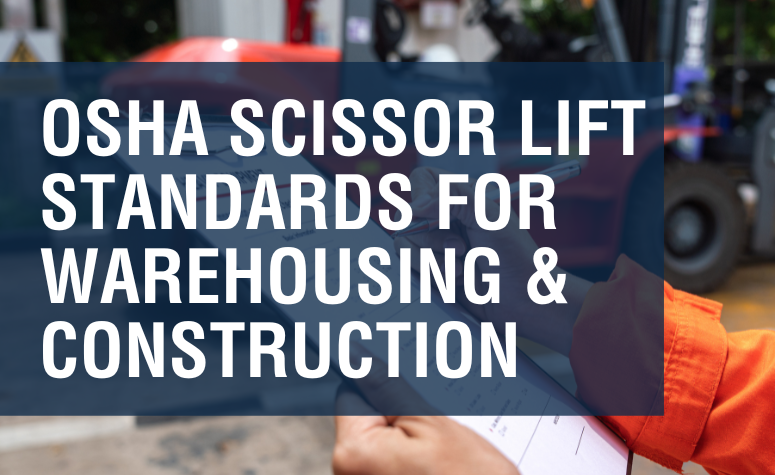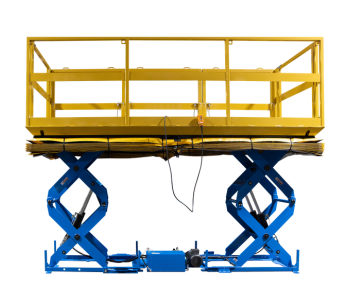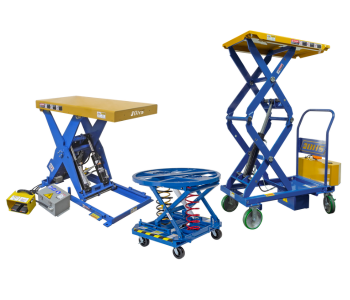We use cookies to make your experience better. To comply with the new e-Privacy directive, we need to ask for your consent to set the cookies. Learn more.
OSHA Scissor Lift Standards for Warehousing and Construction
By 2016, the Occupational Safety and Health Administration (OSHA) was ready to address the safety issues associated with scissor lifts.

More precisely, OSHA was concerned with personnel lifts, not the scissor lifts that are designed to position work or elevate materials. While both types of lifts are valuable in warehousing, manufacturing, construction, and many other industries, we’ll confine this discussion to personnel lifts — because that’s what OSHA’s 2016 guidance covers.
In a single year, OSHA recorded 20 serious injuries — and 10 deaths — involving scissor lift accidents. The resulting study found that these injuries overwhelmingly resulted from three employer mistakes:
- Failing to enforce fall protection standards.
- Improper stabilization of scissor lifts prior to use.
- Lack of training on safe lift positioning.
The safety experts at OSHA responded by publishing a special Hazard Alert about scissor lifts. This 2016 document remains useful for today’s employers, but only up to a point. It discusses fall protection, stabilization, and positioning in detail.
But from a compliance perspective, the Hazard Alert is out of date for most industries, including warehousing. If you’re looking for guidance on OSHA Scissor Lift Standards in “general industry” — which essentially means everything but construction, maritime, and agriculture — you’ll need to dig a little deeper.
Or you could simply keep reading this article. Here’s an updated list of OSHA scissor lift standards for both general industry — including warehousing and logistics — and the construction industry.
First, though, we’ll explain how a 2016 Hazard Alert from OSHA fell so quickly out of date.
Note: This material is provided for information purposes only, and shouldn’t be misconstrued as legal advice. Consult a qualified workplace safety specialist for detailed guidance on OSHA compliance.
How the OSHA Scissor Lift Standards Changed
As we mentioned, OSHA’s last detailed look at scissor lift safety occurred in 2016. At that time, OSHA’s guidance for general industry referred largely to the standards found in 29 CFR 1910 Subpart D - Walking-Working Surfaces.
Around the same time, however, OSHA was working to revise these exact standards. In 2017, most of the updated Walking-Working Surfaces and Fall Protection standards took effect. That made the references in OSHA’s Scissor Lift Hazard Alert obsolete.
For example, the Hazard Alert refers to the following rewritten standards:
- 23 — Guarding Floor and Wall Openings and Holes. Today, 1910.23 covers ladders instead.
- 28 — Safety Requirements for Scaffolding, is now titled Duty to Have Fall Protection and Falling Object Protection.
- 29 — Manually Propelled Mobile Ladder Stands and Scaffolds seemed to directly address equipment like scissor lifts. Now, that numbered standard refers to Fall Protection Systems and Falling Object Protection Criteria and Practices.
Some of these numbered standards still cover the use of scissor lifts to elevate personnel. New standards do, too. Let’s take a look at the updated list of OSHA scissor lift standards.
OSHA Scissor Lift Standards for Warehouses and General Industry
First and foremost, OSHA can intervene when employers allow any unsafe working conditions. That’s thanks to the OSH Act of 1970, which requires employers to provide workplaces “free from recognized hazards that are causing or are likely to cause death or serious physical harm.”
The best way to achieve OSHA compliance is to eliminate unsafe conditions, whether they’re mentioned in a specific standard or not. That said, OSHA refers to the following three updated standards in its latest guidance on the safe use of scissor lifts:
1. 1910.27(a) — Scaffolds and Rope Descent Systems — Scaffolds
This is important: OSHA often considers personnel scissor lifts to be a form of scaffolding, subject to its rules on scaffold use.
This standard tells us that scaffolds — and, by extension, scissor lifts — in general industry must follow the construction industry’s rules on scaffolding. These can be found in 29 CFR 1926, subpart L, which we’ll discuss in our section on the construction industry.
2. 1910.28(b)(12) — Duty to Have Fall Protection and Falling Object Protection — Scaffolds and Rope Descent Systems
Practically, this standard tells us the same thing as 1910.27(a): General-industry operators should refer to the construction industry’s scaffolding standard (1926 subpart L) when using scissor lifts.
However, there’s a different emphasis that makes a more subtle point. These standards clearly place the responsibility for compliance on the employer, not the lift operator. They say:
The employer must ensure each employee on a scaffold is protected from falling in accordance with 29 CFR part 1926, subpart L…
In other words, compliance is the employer’s responsibility.
3. 1910.29(b) — Fall Protection Systems and Falling Object Protection Criteria and Practices — Guardrail Systems
This set of standards provides technical requirements for the guardrails that must enclose a staff-aboard scissor lift. In fact, the addition of these guardrails is often the biggest difference between a material scissor lift and a personnel lift.
These standards provide a list of technical requirements for scissor lift guardrails, including:
- Rails must rise at least 42 inches (107 centimeters) above the platform surface, plus or minus three inches (eight centimeters).
- Guardrails must be able to endure impacts of at least 200 pounds within two inches (five centimeters) of the top rail edge, anywhere along that top rail.
- A top rail must not bend down to less than 39 inches (99 centimeters) from the platform when exposed to a 200-pound downward force.
See the standard, linked above, for a full list of guardrail requirements for your scissor lifts.
These general-industry standards cover the warehousing industry. However, they also refer operator
s in these industries to refer to standards used in construction. Here are the OSHA construction standards listed in the official eTool for scissor lifts.
OSHA Scissor Lift Standards for the Construction Industry
Three of the following OSHA scissor lift standards are found in 1926 Subpart L, referred to in the general industry rules. But that isn’t the only section of OSHA’s construction standards that apply to scissor lifts. We’ll note which standards apply to both general industry and construction in our list below:
1. 1926.20(b) - Accident Prevention Responsibilities
Like general industry’s 1910.28(b)(12), this standard places the responsibility for preventing workplace accidents firmly on the employer. It also prohibits the use of equipment — including scissor lifts — that don’t comply with OSHA safety standards.
Finally, it limits the use of equipment and machinery to trained, qualified employees. This brings us to the next standard on our list.
2. 1926.21 — Safety Training and Education
This standard makes it the employer’s responsibility to educate employees on three particular workplace safety tasks:
- Recognizing unsafe working conditions.
- Avoiding unsafe working conditions.
- Understanding the OSHA regulations that apply to hazard control, elimination, and exposure.
The standard also recommends that employers use safety programs that OSHA offers. Learn about programs related to scissor lifts by calling OSHA at 800-321-6742, or find your local office.
3. 1926.451 — General Requirements
From this standard on, the rest of the items on our list belong to Subpart L of the 1926 standards. That means they officially apply to general industries such as warehousing as well as construction.
These general requirements provide a long list of technical details about compliant scaffolding equipment. Typically, they will apply to scissor lifts designed to elevate personnel (although they don’t apply to aerial lifts, which are considered a separate class of positioning equipment).
Rules that apply to most scissor lifts include:
- Equipment must safely support at least four times the maximum intended load, plus the equipment’s own weight, without failure or collapse.
- Working surfaces on lifts must be fully covered (“planked or decked”), with no more than a 1-inch gap between the platform and the vertical guardrails.
- Scissor lift users must never exceed maximum intended loads or rated capacities, whichever is less, on the working surface.
For the full list of technical requirements, consult the standard, linked in the section heading above.
4. 1926.452(w) — Additional Requirements to Specific Types of Scaffolds
The appearance of this standard on the OSHA scissor lift eTool provides a helpful clue about how the Administration governs use of this equipment. The broader 1926.452 standards provide detailed requirements for specific types of scaffolds. This one is about “mobile scaffolds.”
That implies OSHA considers scissor-style personnel lifts to be a form of mobile scaffold. These (w) standards provide technical specifications for the use of mobile scaffolds, apparently including scissor lifts. Examples include:
- Scaffolds (and, presumably, scissor lift platforms) must be level, plumb, and squared.
- Employees shouldn’t be able to ride this equipment, except within narrow, safe conditions (like level floors and absence of obstructions, to name just a few).
- Mobile scissor lifts shouldn’t move faster than one foot per second.
For a full list, see the standard.
5. 1926.454 — Training Requirements
Several standards have referred to employee training. This Subpart L standard — applicable to both general industry and construction — defines some of the requirements of these training programs.
Employees who use scissor lifts or other types of scaffold should be trained on the following subjects:
- Fall hazards
- Electrical hazards
- Hazards related to falling objects
- How to use the equipment
- How to handle materials safely on the equipment
- Equipment specifications, such as maximum loads and capacities
- Other topics that lead to safer use of scissor lifts
As with the other standards on this list, read the full text of OSHA’s rules to understand compliance requirements. Note that this list is not intended to be comprehensive.
If you’re looking for an OSHA-compliant scissor lift for personnel, learn about the Aerial Work Platform from BHS. For material lifts and work positioners, explore our whole collection of Lift Tables and Pallet Positioners. Questions? Call the BHS sales team at 1.800.247.9500 today.


